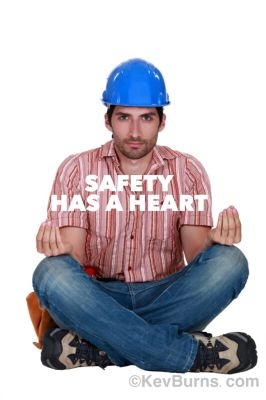How To Supercharge Safety Buy-in
If you want to impact safety performance and buy-in, you are going to have to make a heartfelt connection.
 Finding a way to get front-line employees to buy-in to safety is tough. Communications can be a bit uncomfortable too, especially during the awkward one-on-one, heartfelt moments.
Finding a way to get front-line employees to buy-in to safety is tough. Communications can be a bit uncomfortable too, especially during the awkward one-on-one, heartfelt moments.
Supervisors and safety personnel need to communicate effectively with employees. Even though you don’t want to see anyone get hurt, you still take an arm's-length approach. You default to the innocuous, “don’t get hurt” or “stay safe” or some variation. But don’t get hurt is not a complete set of instructions. Nor is stay safe. And they certainly don’t convey any heartfelt feelings.
What not to do (don’t get hurt) is impossible to actively pursue. It’s the reason why you don’t bring a list of things not to buy to the grocery store. It is a useless list. So is don’t get hurt. These are called performance-avoidance goals (Elliot & Harackiewicz, 1996).
You Don't Build Shelters During A Tornado
Employees know deep down that you don’t want them to be hurt. But more than wanting to be safe, people want to feel safe. Make people feel safe and they will make far better decisions than they would under duress and threat of impending injury.
People don’t build tornado shelters when the wind is swirling all around them. Their immediate need is to avoid danger. When the storm has subsided and there is a feeling of safety, people can rationally and purposely plan their safety strategy.
You can best help your people make good decisions about their long-term safety when they feel safe.
Why Not Get Hurt?
If you tell someone to not get hurt, are you prepared to answer the question they could ask: why not? What if someone asked “why not get hurt?” Would you be prepared to answer that question? Here are some of the typical responses that might tumble out of your head:
- Your family would be devastated
- Think of the trauma your team would suffer
- It would be a black mark on our safety performance
- You don't want to look stupid
- It will hurt finances, yours and the company’s
- You'll give the company a black eye
- There will be a ton of paperwork to fill out
- Insurance premiums will go up
- You'll make the team and safety department look bad
- You may be incapacitated for the rest of your life
- You may never work again
- You will be a hardship on your family
Most of the responses above are meant to make people feel guilty, not safe. But none of them appeals to the feeling part of why safety is important.
To supercharge safety buy-in, you as a supervisor or safety person are going to have to feel before employees will feel. You are going to have to go to that scary, icky, feelings part of your heart. You must offer up a response that connects with employees, makes them feel valued and makes them feel safe. Stop arguing about complying with safety protocols or a grocery list of responses for wanting your people to stay safe. Instead, connect at a heartfelt level. Say something like this, “because I need you here, your team needs you here, we do our best work when you’re here and I don’t want to lose you.”
Make People Feel Valued
Make people feel that they matter and they are valued. Once done, there is no reasonable argument that an employee could offer to not follow safety.
 Every single employee needs to hear that they are valued, that they are cared for and that they help the crew be their best. People want to know that their contribution is important and that they impact the performance of the crew and the company.
Every single employee needs to hear that they are valued, that they are cared for and that they help the crew be their best. People want to know that their contribution is important and that they impact the performance of the crew and the company.
Most times though, employees never hear it. It’s easier for supervisors and safety people to push protocols, processes and procedures. But if you as a supervisor or safety person won’t feel for the employees, the employees won’t feel for the job. Employees will care about their safety when they know how much you care about them.
If you want to impact safety performance, you are going to have to make a connection. That means getting out of your head and instead, connect at the heart level where people feel they matter. Besides, if you did hurt someone, you would show your heart wouldn’t you? Why wait until that happens?
Kevin Burns gives engaging, entertaining and inspiring presentations to front-line employees at safety meetings. He also works with supervisors and managers on-site or in keynote presentations at conferences. Kevin helps organizations integrate caring for and valuing employees through their safety programs. Kevin Burns is a management consultant, safety leadership speaker and author of 9 books. He is based in Calgary, Canada.
©2016 ZeroSpeak Corporation and Kevin Burns.
No part of this post may be reproduced without the expressed consent of the author.


